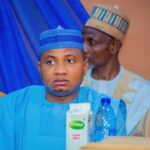Experts have suggested that quick development of rubber plantations in the producing belt can ensure post COVID-19 economic recovery in Nigeria.
The major rubber producing states in the country are in the South where high rainfall is experienced.
‘Why Nigeria is not doing well in rubber production’
15,000 hectares for rubber producers in Cross River
It is commercially grown in Osun, Abia, Anambra, Bayelsa, Akwa Ibom, Rivers, Ondo, Edo, Ogun, Delta and Cross River states.
However, experts in plant breeding told our Agric Editor that advances in plant breeding techniques have given rise to the development of dwarf rubber trees with lower rainfall tolerance.
As a result of sustained research and development programmes, the experts said the natural rubber tree is now grown in Kogi, Niger, Plateau, Taraba, Kaduna and Benue states.
As of today, rubber plantations can be established in 24 out of 36 states of the country.
– Present status of rubber production in Nigeria –
Prior to the 60s, before the oil boom, rubber was one of the agricultural commodities that generated income for Nigeria.
During this period, rubber was an internationally traded commodity and a major foreign exchange earner and contributor to the growth of the economy.
The cultivation of rubber provided bulk employment for the people of the then Mid-West, now known as Edo and Delta states.
However, according to the Director-General of the Raw Material Development and Research Council (RMRDC), Professor Hussaini Doko Ibrahim, natural rubber plantation development in Nigeria has stagnated for the past 30 years, while the ratio of small holdings to large estates plantations is 3:1.
He warned that at present, Nigeria is fast approaching the zero-planting stage as over 80% of the total hectares where the crop is cultivated are over 35 years old.
Natural rubber production peaked to about 236,000ha in the 1990s which gradually declined to the current level of 200,000ha.
The DG said while some countries of the Far East, such as Thailand, Indonesia and Malaysia, account for over 70% of the world production, Nigeria with its enormous potentials and one-time Africa’s leading producer now accounts for just 1.4% of the world output, at the fourth position in Africa.
– Challenges of natural rubber production in Nigeria –
Mr. Ajayi Sobowale, a rubber farmer in Sapele, Delta State, said the challenges are many.
He said at present, only about 40% of Nigerian rubber potential is being exploited.
This is as a result of the abandonment and felling of trees, particularly by smallholders for seemingly more lucrative annual food crop production.
According to the RMRDC, the decline in natural rubber production is attributed to the marginalisation of rubber as an economic and strategic crop due to the discovery of crude oil, the aftermath of the dissolution of the Natural Rubber Board that gave rise to transient glut in the mid-1990s and a drastic drop in the price of the commodity.
Others, according to Mr. Ajayi Sobowale, are the low yield due to uneconomic size of farmer’s holdings, old age of plantations leading to reduced stands per hectare, application of little or no agricultural inputs like fertiliser, unavailability of credit facilities, and pesticides.
Also a disincentive is the gestation period for rubber, which is seven years during which period the farmer earns no income from the trees; shortage and high cost of labour in many rubber producing areas where the industry is forced to compete for labour with the oil sector, as well as scant federal and state governments attention to the sector.
Other very important challenges of the sector are lack of medium and long-term facilities and high cost of credit to finance private plantations.
The RMRDC boss said there was also high cost of inputs and processing facilities as a result of energy supply problems.
In addition, there is dearth of good tappers as untrained tappers were killing the trees.
The age of the trees must also be taken into consideration as most of them are over 30 years old.
Meantime, although a presidential initiative has been launched for production and utilization of rubber in Nigeria, not much has been achieved in the sector yet.
– Presidential Initiative on Rubber Production, Utilisation and Export launched in 2006 –
The Presidential Initiative on Rubber was launched in 2006 to promote increase in the production and processing of rubber locally.
Among the objectives of the initiative is to increase production through resuscitation of plantations, establishment of new plantations, expanding the number of hectares under cultivation, promotion of yield improvement using improved clones and to address technological and socio-economic constraints militating against increased productivity
It also aims at a diversification of local use of rubber and expanding the market through provision of infrastructure and exploring more local and overseas markets.
The initiative was jointly funded by the Federal Government of Nigeria (25%), State Governments (30%), Local Governments (5%), and private stakeholders and donor agencies (30% and 10%) respectively.
It is also planned to develop about 360,000 hectares of rubber plantation between 2007 and 2018.
Had the programmes been sustained, by 2018, the country’s total rubber estates would have been 6000,000ha capable of producing 1.4 million tonnes of crumb rubber worth over $2.7 billion annually.
The programme, however, suffered neglect as no budgetary provision was made for it from 2007 till date to ensure continuation of the scheme.
While the project was expected to be sustainable and last for at least 10 years, it has since stalled.
These, coupled with other problems, led to the exit of Michelin and Dunlop from Nigeria.
– How rubber production can aid post-COVID-19 economic growth –
An agriculturist, Mr. Michael Ifaola, said the need for the country to see natural rubber as a very important post-COVID-19 era option for the development of the non-oil sector in Nigeria is premised on several factors.
One, is the increasing price of rubber which is encouraging rubber cultivation as an economically viable enterprise.
The second is its multiple industrial applications.
He said there are over 50 by-products of rubber, cutting across all major sectors.
“Even, in this COVID-19 pandemic era, natural rubber is playing a great role in fighting against the spread of the disease.
While the world is praying that the era of the pandemic passes quickly, the global natural rubber economy is experiencing a boost.
It will not be out of place to say that natural rubber processing increased economic activities globally by more than 30% during the lockdown.
“RMRDC has identified it to be important in the production of Personal Protective Equipment among which are boots, gloves,’’ the RMRDC DG said.
Experts want the federal government to woo back the big companies that have huge investments such as Michelin and Dunlop and also promote and encourage establishment of small scale industries for value addition across the entire value chain in the country.
“It is also important that we mitigate the challenges facing the sector by promoting healthy reforms in the power sector, and abolish practices such as multiple taxation, etc., that discourage industrialists generally,’’ one of the experts said.
The RMRDC DG said the development of natural rubber alone in Nigeria could generate more than N2 trillion annually both in terms of foreign exchange and local currencies.
He said this is the type of development Nigeria requires in the post-oil and post-COVID-19 pandemic eras.
– FG ready to develop rubber subsector – RMRDC –
The Director General of RMRDC, Professor Hussaini D. Ibrahim, insisted that rubber is one of the commodities that sustained Nigeria’s foreign exchange earnings overtime and both the production and industrial bases were established in the country.
He said despite the challenges facing rubber development, Nigeria still has about 200,000ha of rubber plantations that could be used as a springboard of post-COVID-19 era economic growth in view of its industrial potentials and the presence of a number of viable processors in the country.
The DG said the council was reinvigorating and strengthening its collaboration with the Natural Rubber Producers, Processors and Marketers Association of Nigeria (NARPPMAN) to promote sustainable development of natural rubber through guaranteeing supply of natural rubber to user industries and promoting value-addition to the commodity through domestic processing.
He said NARPPMAN had developed a 10-year roadmap for the development of rubber in Nigeria.
The main objective of the roadmap is to establish 160,000 hectares of rubber plantation that will yield 8,649,760,000kg net weight of natural rubber in a 25-year cumulative period.
“This dovetailed into our competitiveness project,” he added.
“The Raw Materials Research and Development Council has a programme under which it promotes production of agricultural commodities through the provision of improved planting materials.
The council is also collaborating with other private and public sector organizations to produce improved planting materials for this initiative,’’ he also said.

 Join Daily Trust WhatsApp Community For Quick Access To News and Happenings Around You.
Join Daily Trust WhatsApp Community For Quick Access To News and Happenings Around You.


